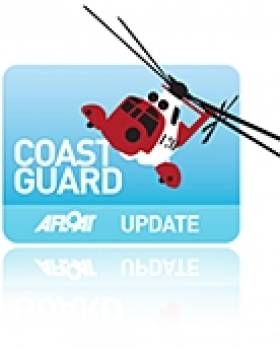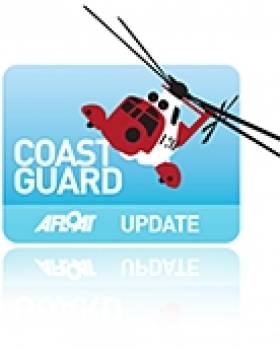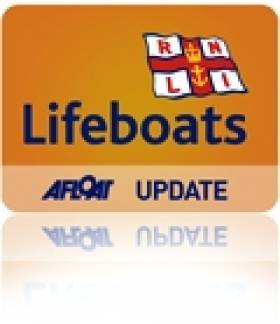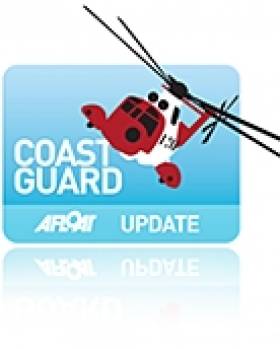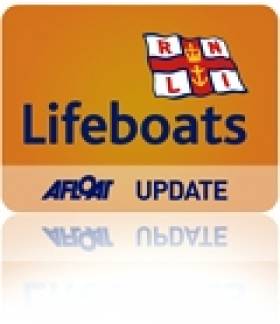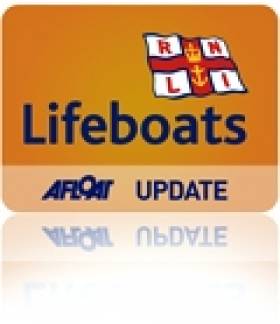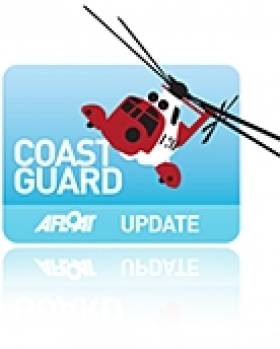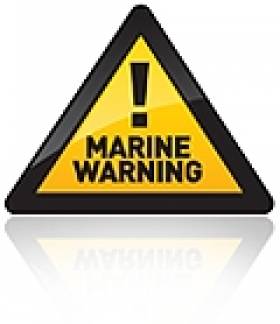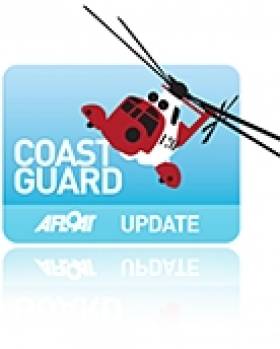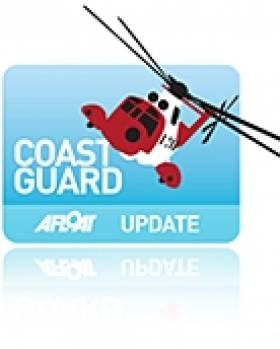Displaying items by tag: Coastguard
Missing Surfers Found in Cave
Coastguard and Lifeboat services were pressed in to action early this morning to search for missing surfers on the North Coast.
At 02.20 am MRCC Belfast received a call from Police Service Northern Ireland reporting that they had received a call from a lady reporting that her son had not returned from a surfing trip with a colleague.
They had gone surfing at 6.00 pm yesterday evening and were due to return at 11.30 pm.
Belfast immediately called out the Coleraine Coastguard rescue team and requested the launch of the Portrush RNLI lifeboat and inshore lifeboat. The Coastguard helicopter R118 from Sligo, Ireland was also scrambled. PSNI officers with dogs were also assisting in the search.
A search was initiated based on the location of their car which was located at Whiterocks car park containing their personal items and their board covers.
At 3.45 am this morning, the two surfers emerged from a cave. They had gone surfing when one of the surfers sustained a head injury when thrown onto the rocks by the waves. They went into a cave to shelter. They think had been there 6 hours could not get out due to the waves. They were waiting until waves subsided, saw the boat and came out of the cave when a little shore line appeared. The men then went onto the road and met the Coastguard search team.
Liam Colquhoun, Watch Manager Belfast said:
We are pleased that the two men have been located. They have declined any medical treatment and have gone home.
The two men had done the correct thing in making sure that a shore contact knew when they were due to return from undertaking their activity.
If you see someone in trouble at sea or on the coast, Dial 999 and ask for the Coastguard.
A German yacht took the yacht in tow, shadowed by a Turkish Coastguard boat into a safe bay at Kemile. Just after 3.00 pm the crew of the vessel was reported to be on dry land and all were safe and well.
Paul Harrison of Liverpool Coastguard says:
"It is unusual for a member of the public to call us about an incident off Turkey. In this situation we worked with our colleagues in Falmouth, who contacted the yacht's crew and the Turkish Coastguard. I am pleased to hear that the people involved are now safe and well.
"If you are going to charter a pleasure vessel abroad we would suggest that one of the first things that you should find out is who to call if you find yourself in an emergency situation. If you are in the UK you should either contact the Coastguard by calling 999 and asking for the Coastguard or marine VHF or MF radio."
Skerries RNLI Lifeboat was tasked last night at 8pm to reports of an upturned hull in the water off Donabate Co Dublin. The lifeboat was launched within six minutes and with the help of the Coast Guard Helicopter "Rescue 116" quickly located the object in the water. The object turned out to be a racing mark that was not floating correctly. The boat returned to station, refuelled and was ready for service before 10pm
Dublin Bay Mudflat Rescue Caught on Video
A Dubliner had a lucky escape after being stranded on mudflats between Baldoyle and Sutton Point, on Dublin Bay last week.
The man had sunk waist-deep in mud on a low tide and was unable to free himself. Dublin Fire Brigade was tasked to the scene along with the Howth Coast Guard unit. The Youtube clip of the entire incident is below.
Rescue helicopter 116, which was already on the ramp at Dublin Airport in preparation for a training exercise, was also tasked at 16.18pm according to a report on the the SAR Ireland blogspot.
After obtaining permission to cross the 'Live' runway at Dublin airport, R116 was on scene within minutes and quickly identified the man who was described as wearing 'dark clothing'. He was quickly winched to safety and returned to Dublin Airport at 16.36pm, where he availed of crew facilities to clean himself down and arrange transport home.
More on Dublin Bay here
Dun Laoghaire Lifeboat Rescues Four as Speedboat Hits Rocks
Four people were rescued by the Dun Laoghaire RNLI lifeboat earlier today when their small powerboat hit rocks off Killiney Beach in south county Dublin. Nobody was injured in the incident that occurred shortly after 11am while the two men and two women were enjoying a pleasure outing.
The 22-foot open powerboat hit the submerged rocks two hours after low-tide and the collision caused damage to the engine. The crew contacted the Irish Coastguard who alerted the RNLI at Dun Laoghaire and the all-weather lifeboat (ALB) launched within ten minutes.
The casualty vessel dropped anchor close to the rocks to avoid being driven onto the beach by the fresh breeze and flood tide. On arrival, the ALB launched its daughter boat with two crew that passed a tow-line to the casualty that was then brought to Dun Laoghaire.
"Before taking a boat-trip, its important to check for local knowledge that will help avoid significant hazards," commented Stephen Wynne, Lifeboat Operations Manager at Dun Laoghaire. "The four people rescued were all wearing life-jackets and followed the correct procedure in calling for assistance."
While lifeboat crew assembled, Belfast Coastguard broadcast a requested for any vessel in the vicinity of Groomsport to give all necessary assistance to the stricken vessel and her crew.
Fishery Protection Vessel Banrion Uladh was making her final approach to Bangor Harbour when the rescue alert was received. Understanding the urgency of the situation Captain Eccles responded immediately and ordered full speed towards the grounded vessel.
When on scene the Banrion Uladh launched a Rigid Inflatable Boat which was able to transfer four children from the stricken boat to the safety of the Fishery Protection Vessel. The speedboat was successfully towed off the reef. With the owner onboard RNLI Bangor Lifeboat towed the vessel to the safety of Bangor Harbour.
Captain Eccles of the Banrion Uladh also a RNLI volunteer at Bangor used this opportunity to highlight the RNLI's free sea safety check when he said 'The RNLI is a charity dedicated to ending preventable loss of life at sea, with hopefully good weather on the horizon and the boating season fast approaching it would be an ideal time for boat owners or skippers to think about a sea safety check. This free check offers excellent sea safety advice along with practical advice on what to do in an emergency. You can book your free sea safety check by contacting the RNLI Sea Safety Officer Peter Bullick on 07802 537371, he would be delighted to hear from you.'
DSC Radio Distress Alert from Ireland Triggers Major Search
At 7.50pm on Saturday, Holyhead Coastguard received a VHF DSC automated distress alert, with no position and a search was launched involving four lifeboats, three Coastguard Rescue Teams and Rescue Helicopter 122 from RAF Valley. The search area encompassed 706 square miles.
Holyhead Coastguard identified the MMSI for the radio unit to be from a derelict fishing vessel in the Republic of Ireland and Dublin Coastguard confirmed the vessel had been broken into at some point and the radio unit taken. Without the details of any new vessel and current owner of the radio unit, Holyhead Coastguard was unable to determine if the distress alert was genuine or a false alert without a search.
Holyhead Coastguard Watch Manager Andy Carroll said,
"Anyone buying a second hand VHF DSC radio must ensure the details are updated on the MMSI database and familiarise yourself with how to operate the unit and how a distress alert is made. This is vital for an effective search and rescue operation should you get into difficulty."
Andy went on to say,
"If you think you have inadvertently sent an automated distress alert, don't hesitate to get in contact with the Coastguard. We would much rather know that it is a false alarm than continue searching needlessly."
VHF DSC and MMSI – explanation of terms used:
Carrying a VHF radio on your vessel is vital and VHF DSC (Digital Selective Calling) is strongly recommended. Ensure your radio equipment is fully working and you know what to do in an emergency. With DSC you can send a distress alert along with your exact position, with one touch of the button. The distress alert is repeated every four minutes until it is acknowledged either by a Coastguard Station (Ship to Shore) or by a vessel (Ship to Ship) within radio range.
Ensure you have updated your MMSI details – this is especially important if you have just bought the boat with a radio already installed or you are installing a new DSC, radio set. Maritime Mobile Service Identity ( MMSI) numbers are programmed into a DSC radio set and an MMSI is issued as part of your radio licence application, via Ofcom. It consists of a series of nine digits, which are used to uniquely identify the radio on your vessel.
Don't Drink and Drown this Sumer - UK Coastguard Issues Warning
Liverpool Coastguard requested the launch of Workington RNLI all weather lifeboat and sent Whitehaven Coastguard Rescue Team to the scene. After a search in darkness for the casualty vessel which had no navigation lights, Liverpool Coastguard received a 999 call by mobile phone from one of the occupants of the boat. Workington lifeboat then located them further north of the initial sighting and towed the broken down vessel into Workington.
Members of the public were concerned for their safety because the men appeared to be drunk before departing the harbour. It was reported that the two men had boarded the boat in Harrington Harbour earlier in the evening and that the skipper had fallen overboard in the outer harbour and his friend had got into the water to help him back in before they set off towards Workington. The boat was seen broken down and drifting about a quarter of a mile offshore just before nightfall.
Liverpool Coastguard Graham Parr said,
"As the weather warms up more people want to get out and enjoy being on the water but please don't take unnecessary risks this summer; don't drink and drown. Not only does it impair judgement but alcohol will also affect your ability to deal with an emergency situation.
Always check your vessel is seaworthy before setting out and if you must travel in darkness, navigation lights are both vital and mandatory.
For guidance, see SOLAS V regulations for pleasure craft http://tinyurl.com/3nns78m
Three 14 Year Olds Cut off By Tide
At 16.52 a member of the public called Liverpool Coastguard to report that they could see three children who had been by the tide on sandbanks on the River Mersey between Runcorn and Widnes. With still over an hour to go to high water, Liverpool Coastguard requested the RNLI New Brighton Inshore Lifeboat and Hovercraft, as well as informing Merseyside and Cheshire Fire and Rescue services. A rescue helicopter from RAF Valley was also requested as it was feared that the children may have been overrun by the flood tide before lifeboat and hovercraft could get there. Fortunately, Cheshire Fire and Rescue service were able to launch their inflatable boat and recover the three 14-year-olds, who, at 17.24, were reported as safely ashore - cold but otherwise unharmed.
Liverpool Coastguard Watch Manager Paul Parkes said:
"With the onset of the flood tide fast approaching and the three children stranded on the sandbank, if it weren't for the quick response of the Fire and Rescue Service this incident could have had a very different ending. With the extended Easter school holidays, we would urge parents to be mindful of the whereabouts of their children at all times and to warn them of the dangers of being cut off by the tide."
Liverpool Coastguard Rescues 93 People
The first call came in at 13.13 when four people became stranded near Fleetwood. Fleetwood Coastguard Rescue Team proceeded to the scene and they were safely brought ashore. The Lytham Coastguard Rescue Team were then tasked to a report of 70 people cut off by the tide at Blackpool near the South Pier. With Blackpool Beach Patrol and the Blackpool RNLI Lifeboat also on scene assisting everyone was subsequently reported as safely back to the shore.
At 13.41 Liverpool Coastguard received reports of two separate groups (one of five people, and one of nine people including four children) who had become stranded on sandbanks in Blackpool off Norbreck Castle. Once again Fleetwood Coastguard Rescue Team were sent to assist in getting them safely back to the shore.
At 14.35 Liverpool Coastguard sent Arnside Coastguard Rescue Team to a woman and two dogs who were cut off by the tide at Sandside near Arnside. The Morecambe RNLI Hovercraft was launched and took the lady and her dogs back to safety.
Finally, at 14.41 Liverpool Coastguard received a call reporting four girls potentially stranded on the spit at Little Eye in West Kirby. Hoylake Coastguard Team attended to investigate but the girls were deemed to be not in danger.
Liverpool Coastguard Watch Manager Su Daintith said:
"We know that on a beautiful like today that people don't want to waste any time getting to the beach in order to soak up the sunshine. But just two minutes spent checking the tide times (and there are plenty of resources available where you can find these) could mean the difference between a carefree day and a Coastguard Team coming to your rescue."



























